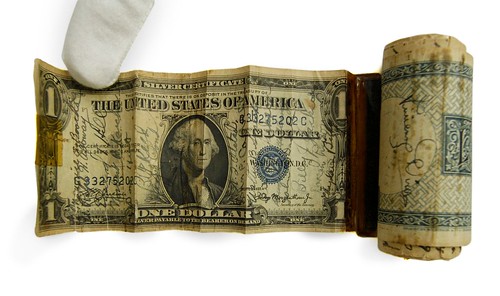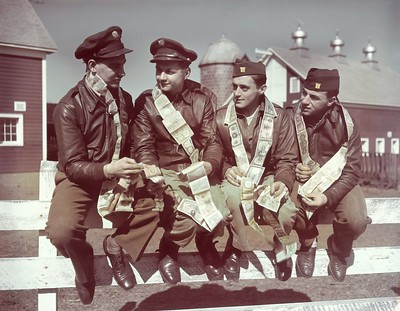
PREV ARTICLE
NEXT ARTICLE
FULL ISSUE
PREV FULL ISSUE
V25 2022 INDEX E-SYLUM ARCHIVE HOW TO SPOT A ‘SHORT SNORTER'Pablo Hoffman passed along this new Atlas Obscura article on short snorters. Great photos! Thanks, -Editor
AT FIRST GLANCE, THE DOLLARS look like any others, tinted with age with some bearing the familiar visage of George Washington and others adorned with faces that aren't easily as identifiable. But upon closer inspection, these bills are covered with signatures and are taped to one another, like an odd and expensive celebratory banner. This is a The short snorter in the Air Mobility Command Museum collection belonged to Tom Farrow, a B-17 crew member of the 384th Bomb Squadron who escaped the burning wreckage of his bomber before being taken as a prisoner of war in Germany during World War II. After being rescued, he retired to Delaware and donated his short snorter to the museum, along with his diary and dog tags. It would have been rolled up for easy transport, only unrolled when a new bill or signature was added from a colleague or famous figure.
The tradition of the short snorter is believed to have started with Alaskan bush pilots in the 1920s, who would leave autographed bills in the small towns they flew into. What is certain is that it was popularized by stunt pilot Jack Ashcraft of the Flying Gates Circus after a show in Syracuse, New York, in 1925.
Ashcraft was sent to find champagne for a party but got distracted by a female companion so the next day, when he was reprimanded for his disappearance, he sidetracked his boss by asking him for two dollars. Ashcraft scrawled
The scheme became especially popular with other pilots, who recruit members into their fold by simply taking their dollar bills and signing one as an initiation. Eventually a whole set of The tradition picked up steam in the military mess halls of World War II as more people made these long-haul flights to Europe, Short snorters became a sort of good luck charm as fellow passengers signed the bills. When you filled one bill, usually a small sum, you taped onto another, including foreign currency picked up in your travels. It became a ledger of where you flew and who you flew with.
To read the complete article, see:
Wayne Homren, Editor The Numismatic Bibliomania Society is a non-profit organization promoting numismatic literature. See our web site at coinbooks.org. To submit items for publication in The E-Sylum, write to the Editor at this address: whomren@gmail.com To subscribe go to: https://my.binhost.com/lists/listinfo/esylum All Rights Reserved. NBS Home Page Contact the NBS webmaster 
|


